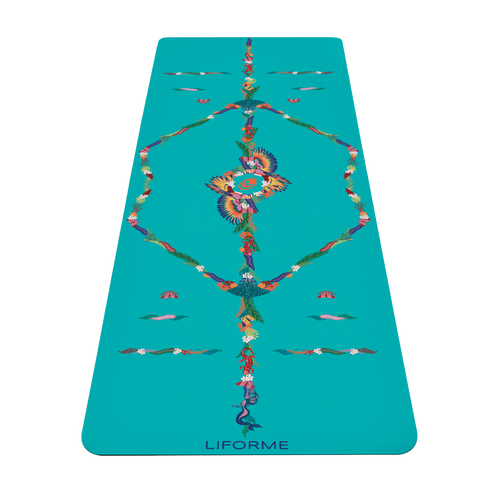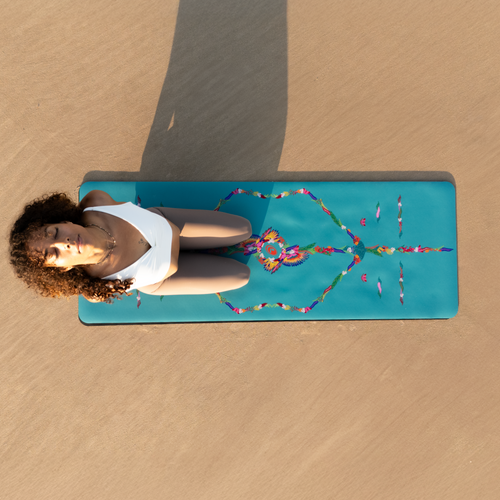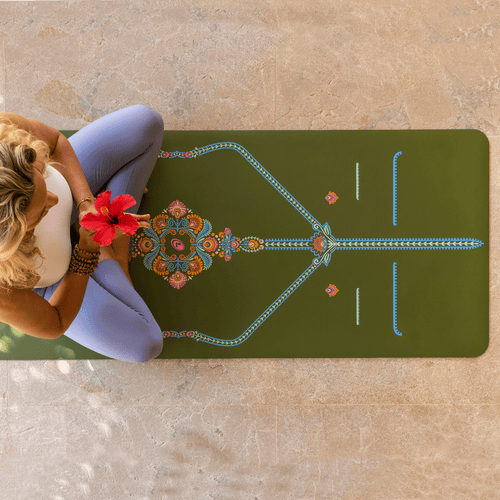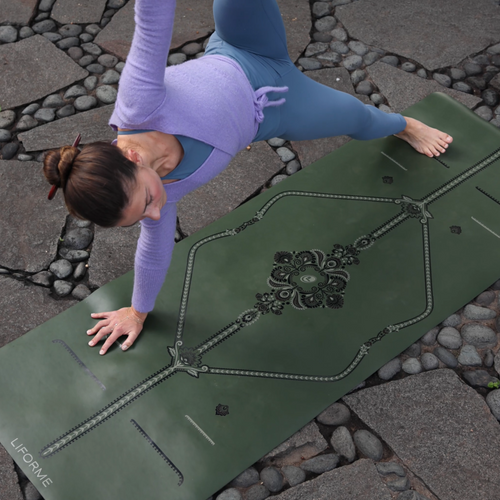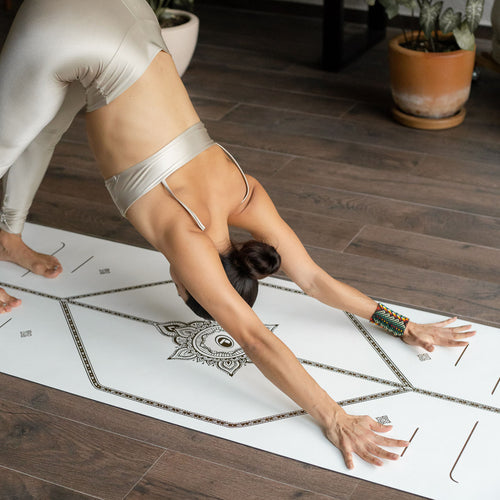We humans like to feel like we know what’s coming. We are most comfortable when we have a map of the next few turns in the road, an inkling of what might be over the next rise. Even when we've laid our best plans, however, we can never be quite sure what the future holds. When the world seems especially unpredictable, our anxiety rises. Uncertainty makes us stressed and unhappy.
The Benefits of Yoga for Stress and Uncertainty
When trying to stay balanced on constantly shifting ground, students of yoga do have a bit of an advantage. Many of the lessons, both physical and mental, that come into your life through practicing yoga consistently help you first acknowledge, and then begin to alter, your relationships with uncertainty. Over time, you can start to change your attachments to particular outcomes, which helps you regain your equilibrium when things start to go a bit haywire.

Techniques for Finding Balance Through Yoga
Get Comfortable with Discomfort
Staying in a thigh-burning posture like Warrior II a little longer than you’d like isn’t the same as dealing with chaotic life events, but it is a way of training the mind to handle discomfort. When you’ve done something difficult and come out on the other side, you see that it’s possible. Building challenges and successes into your life on a small scale prepares you to deal with larger issue when they inevitably arise.
Techniques like positive self-talk that work on your mat also work out in the wide world. Most of us don’t choose to be uncomfortable that often, but when we do it in a safe place like a yoga class, we can learn that we are more resilient than we thought.

Use the Breath to Ground Yourself in the Present
When the big picture is overwhelming, focus on the little picture. Each breath you take serves as a reminder that you’re still here and that you are ok. In and amongst the feeling of being unsettled, you can still find moments of pleasure and joy. Acknowledge good news, spend time with people who support you, take a moment to lift your face to the sunshine. Deep breathing also calms the nervous system, sending your body signals that you are safe.
Meditation and Mindfulness
Sitting for meditation teaches us how to label thoughts and emotions as they arise without latching onto them in that moment. Identifying your discomfort allows you to distance yourself from it just a little bit. The awareness of the observing mind gives you the perspective to be separate from the anxiety you are feeling.
Yoga Poses for Balance and Stress Reduction
Focus on poses that ground and energize your body, as well allow you to practice balance and relaxation.
Grounding Poses
When your head feels like it might fly off your shoulders, it’s helpful to engage in practices that strengthen your connection to your body. Grounding yoga poses take your attention away from your anxious thoughts, which can stop them from spiralling towards doom.

Mountain Pose (Tadasana)
Sanskrit Meaning: Tada (Mountain)
Yoga Level: Beginner
Pose Type: Standing
Benefits: Promotes good posture. Strengthens the legs and core.
Why this pose: Grounds you by focusing your attention on your postural alignment and breath.
Step-by-Step:
- Come to stand at the front of your mat with your feet touching or slightly separated. Think about stacking your shoulders over your hips and your hips over your ankles.
- Ground down through the soles of your feet. Engage your quads to draw your kneecaps upward. Draw your navel toward your spine. Open the palms of your hands toward the front of the room. Relax your shoulders away from your ears. Bring your head into a neutral position.
- Maintain all the above alignment points while taking several full deep breaths.

Chair Pose (Utkatasana)
Sanskrit Meaning: Utkata (Powerful)
Yoga Level: Beginner
Pose Type: Standing
Benefits: Strengthens the legs, especially the thighs and glutes.
Why this pose: Chair pose emphasizes your relationship with gravity and the dynamic pull between the upper and lower body.
Step-by-Step:
- From Mountain Pose, bend your knees and take your butt back as if you are about to sit in a chair.
- Raise your arms above your head. Your body will be in a zig-zag shape.
- Ground through your legs and feet as you lift through your arms.
 Happy Baby (Ananda Balasana)
Happy Baby (Ananda Balasana)
Sanskrit Meaning: Ananda (Blissful) Bala (Child)
Yoga Level: Beginner
Pose Type: Supine
Benefits: Stretches the inner and outer thighs, hamstrings, and glutes.
Why this pose: Lying on the floor while actively pulling your legs down is very grounding.
Step-by-Step:
- Lie on your back and hug your knees into your chest.
- Separate your knees to either side of your chest.
- Hold on the outside or the inside of each foot.
- Keeping your knees bent, stack your ankles over your knees with the soles of your feet facing the ceiling.
- Keep your shoulders and sacrum on the floor as you draw your feet towards your armpits.
Energizing Poses
Get your energy up with postures that engage your whole body and build heat.

Downward Facing Dog (Adho Mukha Svanasana)
Sanskrit Meaning: Adho (Down) Mukha (Face) Svana (Dog)
Yoga Level: Beginner
Pose Type: Standing
Benefits: Stretches the hamstrings and back muscles, strengthens the quads, biceps, abs, and shoulders.
Cautions: Avoid inversions if you have glaucoma.
Why this pose: The one pose that does it all, opening and simultaneously working every part of your body.
Step-by-Step:
- Come to a hands-and-knees position on your mat.
- Curl your toes under and lift your knees off the floor.
- Straighten your legs as you take your butt toward the ceiling.
- Push into your hands and release your heels toward the floor.

Warrior II (Virabhadrasana II)
Sanskrit Meaning: Virabhadra (a Hindu warrior)
Yoga Level: Beginner
Pose Type: Standing
Benefits: Strengthens the legs, back, arms, and core. Opens the hips, hamstrings, and chest.
Why this pose: Get into your hips and feel the burn in your legs.
Step-by-Step:
- Take a wide stance with your legs apart facing the long side of your mat.
- Position the arches of both feet along the Central Line.
- Pivot on your front heel to turn that foot so that your toes face the front of your mat.
- Bend your front leg until the knee comes directly over your ankle.
- Take your arms up to shoulder height and reach outward through your fingertips.
- Take your gaze over your front fingertips.
- Repeat the pose with the opposite leg forward.

High Lunge
Yoga Level: Beginner
Pose Type: Standing
Benefits: Hamstring stretch, quad and core strengthener.
Why this pose: Continue working your legs while also beginning to challenge your balance.
Step-by-Step:
- From Mountain Pose, step one foot to the back of your mat.
- Stay on the ball of your back foot as you bend your leg to stack your knee over your ankle.
- Take your arms overhead.
- Repeat with the opposite leg forward.
Balancing Postures
The focused attention and physical challenge of maintaining balance provide a very helpful brain break.

Tree (Vrksasana)
Sanskrit Meaning: Vrksa (Tree)
Yoga Level: Beginner
Pose Type: Standing
Benefits: Improves balance, core strength, and leg strength.
Why this pose: Standing on one leg provides the opportunity to improve your balance.
Step-by-Step:
- From Mountain Pose, transfer your weight into your right leg while keeping your hips facing forward.
- Lift your left foot off the floor. Position the sole of your left foot on the inside of your right thigh, using your hands if necessary.
- Press your foot into your thigh and your thigh back into your foot.
- Bring your gaze to something that’s not moving to help with balance.
- Bring your arms overhead. If you are new to the posture, you can do it near a wall that you can reach for extra support.
- Repeat the pose standing on your left leg.

Side Plank (Vasisthasana)
Sanskrit Meaning: Vasistha (A Hindu sage)
Yoga Level: Intermediate
Pose Type: Arm Balance
Benefits: Improves balance, building arm and core strength.
Why this pose: Work up to more challenging arm balance by building arm and core strength.
Step-by-Step:
- Come into a Plank Pose (as if you were going to do a push-up).
- Transfer your weight into your right hand, turning your chest to face the left side of your mat and stacking your left foot on top of your right foot.
- Lift your left hand toward the ceiling and lift your hips.
- After several breaths, return to Plank pose and do the other side.

Crow Pose (Kakasana)
Sanskrit Meaning: Kaka (Crow)
Yoga Level: Intermediate
Pose Type: Arm Balance
Benefits: Improves balance, arm and more strength. Improves body awareness.
Why this pose: Lifting your feet off the floor for any amount of time is a wonderful feeling.
Step-by-Step:
- Come to a squat at the front of your mat.
- Press your palms into the floor about shoulders’ distance apart.
- Come onto the balls of your feet a lift your butt up high.
- Bring your knees into your armpits.
- Begin to take your body weight forward, bending your arms like Chaturanga, which makes your upper arms into shelves for your knees.
- Experiment with taking your weight more into your hands, lifting one foot at a time away from the floor.
Restorative Poses
Include some resting postures to nurture relaxation.

Child’s Pose (Balasana)
Sanskrit Meaning: Bala (Child)
Yoga Level: Beginner
Pose Type: Kneeling
Benefits: Stretches the hips and back, resting posture.
Why this pose: Signals the body to rest.
Step-by-Step:
- From a hands-and-knees position, widen your knee toward the sides of your mat while bringing your big toes to touch at the Central Line.
- Sink your butt back to rest on your heels.
- Bring your forehead to the floor.
- Extend your arms or bring them along your sides.

Legs Up the Wall Pose (Viparita Karani)
Sanskrit Meaning: Viparita (Inversion) Karani (to do)
Pose Type: Inversion
Benefits: Stretches the backs of the legs, improves circulation and lymphatic drainage.
Cautions: Avoid inversions if you have glaucoma
Why this pose: Putting your feet up is always a good idea.
Step-by-Step:
- Come to sit sideways at a wall with your knees bent, feet on the floor, and the entire side of your body in contact with the wall.
- In a single movement, roll onto your back and bring your legs up the wall.
- After several minutes, bend your legs and roll to one side to come out.

Corpse Pose (Savasana)
Sanskrit Meaning: Sava (Corpse)
Yoga Level: Beginner
Pose Type: Supine
Benefits: Rests the body
Why this pose: Make sure you include time to rest in any yoga practice. Set a timer for 10 minutes before you lie down.
Step-by-Step:
- Come to lie on your back with your arms at your sides and your eyes closed.
- Turn your palms to face the ceiling.
- Let your feet fall out to either side.
- Let your breath come naturally.
- Practice releasing your thoughts as they arise.
Change the Things You Can
Uncertainty is a constant. We can't change that, but we can change our relationship to it. When you have the tools to alter your mindset, you can handle the shifting tides with a little more equanimity.












